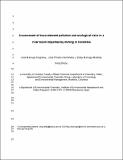Por favor, use este identificador para citar o enlazar a este item:
http://hdl.handle.net/10261/218192COMPARTIR / EXPORTAR:
 SHARE SHARE
 CORE
BASE CORE
BASE
|
|
| Visualizar otros formatos: MARC | Dublin Core | RDF | ORE | MODS | METS | DIDL | DATACITE | |

| Título: | Assessment of trace element pollution and ecological risks in a river basin impacted by mining in Colombia |
Autor: | Marrugo-Negrete, José Luis; Pinedo-Hernández, José; Marrugo-Madrid, Siday; Díez, Sergi CSIC ORCID | Palabras clave: | River water Pollution Trace element pollution in rivers |
Fecha de publicación: | 17-ago-2020 | Editor: | Springer Nature | Citación: | Environmental Science and Pollution Research (2020) | Resumen: | Trace element pollution in rivers by anthropogenic activities is an increasing problem worldwide. In this study, the contamination and ecological risk by several trace elements were evaluated along a 100-km stretch of the San Jorge River in Colombia, impacted by different mining activities. The increase of average concentration levels and range of trace elements in sediments (in μg/g) was as follows: Cu 6656 (454–69,702) > Cd 1159 (0.061–16,227) > Zn 1064 (102–13,483) > Ni 105 (31–686) > Pb 7.2 (5.1–11.7) > As 1.8 (1.0–3.2) > Hg 0.31 (0.12–1.37). Results showed that surface sediments could be classified as very high ecological risk index (RI > 600), associated with high contamination of Hg, Cd, and Cu, in stations close mining activities. Values for pollution load index indicate an environmental deterioration (PLI > 1), and sediment quality guidelines (SQGs) suggested that Cu, Ni, Zn, and Hg caused adverse biological effects. We further used pollution indices such as contamination factor (CF), enrichment factor (EF), and geoaccumulation index (Igeo) to assess the extent of contamination. According to these indices, discharges of hazardous chemicals over many years have resulted in a high degree of pollution for Cu, Pb, and Cd, with critical values in stations receiving wastes from mining activities. Multivariate statistical analysis suggested that Hg, Cd, Cu, and Zn derived from gold and coal mining, Ni and As were related from the mining of ferronickel and coal, respectively, whereas the high Pb load was attributed to diffuse source of pollution. In sum, our study provided the first detailed database on metal concentration and ecological risks to organisms in sediments of the San Jorge River Basin, and the current results also suggested future research for public health action. | Versión del editor: | https://doi.org/10.1007/s11356-020-10356-4 | URI: | http://hdl.handle.net/10261/218192 | DOI: | 10.1007/s11356-020-10356-4 |
| Aparece en las colecciones: | (IDAEA) Artículos |
Ficheros en este ítem:
| Fichero | Descripción | Tamaño | Formato | |
|---|---|---|---|---|
| Pprint San Jorge River ESPR.pdf | Artículo principal | 48,18 kB | Adobe PDF |  Visualizar/Abrir |
CORE Recommender
SCOPUSTM
Citations
18
checked on 13-abr-2024
WEB OF SCIENCETM
Citations
16
checked on 25-feb-2024
Page view(s)
148
checked on 17-abr-2024
Download(s)
124
checked on 17-abr-2024
Google ScholarTM
Check
Altmetric
Altmetric
NOTA: Los ítems de Digital.CSIC están protegidos por copyright, con todos los derechos reservados, a menos que se indique lo contrario.
